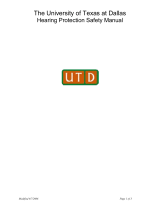
E•A•R 06-08/HPChildren and Hearing Protection … Page - 3
Conclusions
Though products are available that can protect children’s hearing when they are exposed to noise, the
existence of such products is only a small part of the solution to the problem. As with adult users of
safety products it is key that children be taught an awareness of the importance of good hearing, the
hazards of noise, and be provided techniques to determine when their ears may be at risk. Furthermore
they must be given training on the means to protect themselves, either by reducing the frequency,
severity, and/or duration of their exposures, or by wearing hearing protection. This can be accomplished,
but it requires skill and diligence. The good news is that at least a few of the existing studies reviewed in
this report suggest that use trends may be improving and that training and motivation can be effective.
References
Allonen-Allie, N. and Florentine, M. (1990). "Hearing Conservation Programs in Massachusetts'
Vocational/Technical Schools," Ear and Hearing 11(3), 237-240.
Ballachanda, B. B. (1995).
The Human Ear Canal, Singular Pub. Grp., Inc., San Diego, CA, p. 18.
Bennett, J. A. and English, K. (1999). "Teaching Hearing Conservation to School Children: Comparing the
Outcomes and Efficacy of Two Pedagogical Approaches," J. Educ. Audiol. 7, 29-33.
Berger, E. H. (1988). “EARLog #19 – Tips for Fitting Hearing Protectors,” Sound and Vibration 22(10), 22-25
and available at <
http://www.e-a-r.com/hearingconservation/earlog_main.cfm>
Berger, E. H., Neitzel, R., and Kladden, C. A. (2006). Noise Navigator™ database, at
<
http://www.e-a-r.com/pdf/hearingcons/NoiseNav.xls>
Bogoch, I. I., House, R. A., and Kudla, I. (2005). "Perceptions About Hearing Protection and Noise-Induced
Hearing Loss of Attendees of Rock Concerts," Canad. J. Pub. Health 96(1), 69-72.
Broste, S. K., Hansen, D. A., Strand, R. L., and Stueland, D. T. (1989). "Hearing Loss Among High School
Farm Students," Am. J. Pub. Health 79(5), 619-622.
Chermak, G. D., Curtis, L., and Seikel, J. A. (1996). "The Effectiveness of an Interactive Hearing
Conservation Program for Elementary School Children," Lang., Speech, and Hearing Services in Schools
27(1), 29-39.
Chermak, G. D. and Peters-McCarthy, E. (1991). "The Effectiveness of an Educational Hearing
Conservation Program for Elementary School Children," Lang., Speech, and Hearing Services in Schools
22(1), 308-312.
EPA (1979). “Noise Labeling Requirements for Hearing Protectors,” Environmental Protection Agency, Fed.
Regist. 44(190), 40 CFR Part 22, 56130-56147.
Knobloch, M. J. and Broste, S. K. (1998). "A Hearing Conservation Program for Wisconsin Youth Working in
Agriculture," J. Sch. Health 68(8), 313-318.
Korpert, K. (1999). "Hearing Thresholds of 15 to 18 Year Old Pupils and Apprentices," J. Acoust. Soc. Am.
105(2), Pt.2, p. 1009.
Laitinen, H., Suzuki, Y., Iwata, K., Bjork, E., Myyrylainen, P., and Jokitulppo, J. (2001). "Comparison
Between Noisy Leisure Activities of Japanese and Finnish Young People," in
Proceedings of Inter-Noise
2001, edited by R. Boone, Nederlands Akoestisch Genootschap (NAG), Maastricht, The Netherlands, paper
551.
Lankford, J. E., Mikrut, T. A., and Jackson, P. L. (1991). "A Noise-Exposure Profile of High School Students,"
Hearing Instr. 42(12), 19-24.
Lass, N. J., Woodford, C. M., Lundeen, C., Lundeen, D. J., Everly-Myers, D. S., McGuire, K., Mason, D. S.,
Paknik, L., and Phillips, R. P. (1987). "A Hearing-Conservation Program for a Junior High School," Hearing J.
40(11), 32-40.












